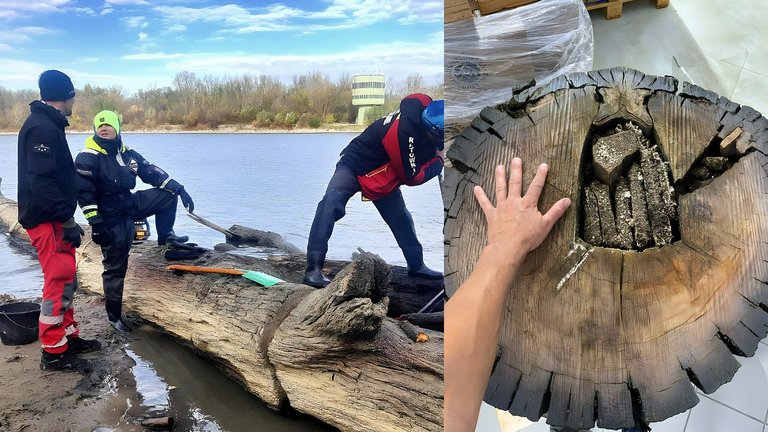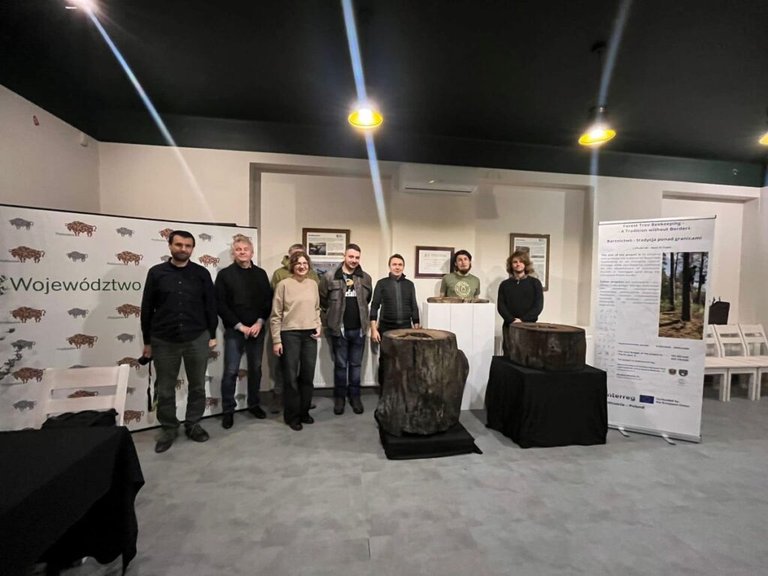
Photos: courtesy Polish Museum of Beekeeping Culture and Barberini Exultet Roll 1070-1100 ca. Vatican Library Barb.lat.592
Deutsch
1300 Jahre alter Bienenstock
Der älteste bekannte Bienenstock (Beute) der Welt wurde in Polen gefunden. Er stammt aus der Zeit um 680 n. Chr. und ist etwa 1300 Jahre alt. Dieser alte Bienenstock wurde im Inneren eines Eichenstammes gefunden und ist ein seltenes Beispiel für mittelalterliche Bienenzucht, da das Material normalerweise der Witterung ausgesetzt ist und kaum älter als 100 Jahre wird. Hier einige wichtige Details:
Der Bienenstock wurde in einer Kiesgrube ausgegraben und war ursprünglich für ein Sägewerk bestimmt. Bei der Untersuchung stellte sich heraus, dass er eine gut erhaltene Bienenkammer enthielt, bekannt als „barć“, mit Resten von Waben, Spuren von Honig und konservierten Bienen.
Dieser Fund bietet einen einzigartigen Einblick in die historischen Bienenzuchtmethoden des frühen Mittelalters, in eine Zeit vor der Blüte der sogenannten Zeidelwirtschaft (1300 n. Chr.-1500 n. Chr.) und in die Naturgeschichte der Honigbienen, bevor moderne landwirtschaftliche Praktiken ihre Umwelt veränderten. Es wird als wissenschaftlicher Schatz betrachtet, der Einblicke in die Biodiversität und Strategien zur Unterstützung von Bienenpopulationen bietet.
Der Baumstamm mit dem Bienenstock ist jetzt im Museum für Bienenkultur in Augustów, Polen, ausgestellt. Wissenschaftler analysieren das biologische Material, um mehr über die Bienen und ihre damalige Umwelt zu erfahren.
Die Entdeckung des Bienenstocks fällt in die Zeit, als Polen Teil des polnisch-litauischen Commonwealth war und die Baumimkerei aufkam. Dabei wurden in lebenden Bäumen oder Stämmen Hohlräume für die Bienen geschaffen, wobei der Mensch nur minimal in den Lebenszyklus der Bienen eingriff.
Wer mehr über das Zeidelwesen und die Baumimkerei erfahren möchte, kann hier einen Artikel von mir lesen oder auch sehr gerne unser Museum in Feucht (Bayern - Deutschland) besuchen.
English
1300 year-old beehive
The oldest known beehive in the world was found in Poland. It dates back to around 680 AD and is approximately 1300 years old. This old hive was found inside an oak trunk and is a rare example of medieval beekeeping, as the material is normally exposed to the elements and is rarely older than 100 years. Here are some important details:
The hive was unearthed in a gravel pit and was originally destined for a sawmill. Upon examination, it was found to contain a well-preserved bee chamber, known as a ‘barć’, with remains of honeycomb, traces of honey and preserved bees.
This find offers a unique insight into the historical beekeeping methods of the early Middle Ages, into a time before the flourishing of the so-called Zeidel economy (1300 AD-1500 AD) and into the natural history of honey bees before modern agricultural practices changed their environment. It is considered a scientific treasure that provides insights into biodiversity and strategies to support bee populations.
The tree trunk with the beehive is now on display at the Museum of Bee Culture in Augustów, Poland. Scientists are analysing the biological material to find out more about the bees and their environment at the time.
The discovery of the beehive dates back to the time when Poland was part of the Polish-Lithuanian Commonwealth and tree beekeeping emerged. This involved creating cavities for the bees in living trees or trunks, with minimal human intervention in the bees' life cycle.
If you would like to find out more about the Zeidel system and tree beekeeping, you can read an article by me here or visit our museum in Feucht (Bavaria - Germany).


Ein spannender Fund!
Auf jeden Fall - da muss ich noch irgenwie in diesem Jahr hin. So ein Fund ist archäologisch wie ein Sechser im Lotto.😎
1,300 years old beehive, this is incredible. I can imagine how many generations who enjoyed honey from this beehive.
Hi Luchyl
you mention:
I think you've misunderstood something. The bees' nest was made by humans 1300 years ago and operated there for a while. Then the tree was buried in a gravel pit and the tree and the bees' nest were preserved there with honey, pollen and bees - similar to mummies in Egypt. The bees' nest was not used for more than 1300 years.
Oh, now I understand. Pardon me for the mix up.
Dieser Hive hatte wahrscheinlich noch keine Blockchain...😅
1300 Jahre...wow!
faszinierend. Danke fürs Teilen.
Danke
Sehr interessant, vielen Dank.
Danke
!BEER
View or trade
BEER.BEERHey @beesmartblog, here is a little bit of from @indextrader24 for you. Enjoy it!BEER at dCity game to buy cards to rule the world.Did you know that <a href='https://dcity.io/cityyou can use